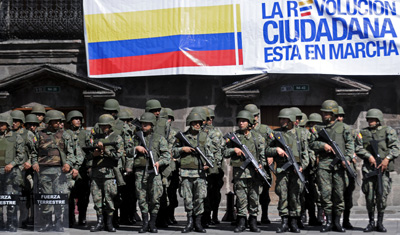New York, October 1, 2010–As a police rebellion threw Ecuador into chaos on Thursday, the government of President Rafael Correa ordered local radio and TV stations to interrupt programming and carry state news broadcasts. A dozen reporters were injured covering the police revolt. Today, the Committee to Protect Journalists condemned the government’s censorship of broadcast media and called on local authorities to investigate and prosecute those responsible for attacks on journalists.
On Thursday, hundreds of officers took over police barracks across the country, protesting legislation passed a day earlier that cuts some of their benefits, international and local media reported. The government declared a state of emergency, and the Communications Ministry sent a directive ordering local radio and TV stations to broadcast programming from Ecuador TV, a state-owned channel.
National broadcasters Ecuavisa, Teleamazonas, and Canal Uno interrupted their regular programming around 2 p.m., switching to the official Ecuador TV broadcast, journalists said. Ecuador TV covered the events from the government’s perspective, interviewing an array of high-ranking officials, local journalists told CPJ. The ministry lifted its order around 8 p.m., and broadcasters returned to their own programming soon after, journalists said.
The ministry’s order, which was reviewed by CPJ, is based on Ecuadoran broadcast legislation authorizing the president and members of his government to interrupt programming in order to broadcast official messages. But neither Correa nor the government broadcast official messages, according to local news accounts. The order instead cut off independent media coverage, preventing citizens from receiving balanced information at the most critical time, Ecuavisa’s regional editor in chief Freddy Barros told CPJ.
Rebel officers broke into the facilities of Ecuador TV around 6.30 p.m., and tried to interrupt the official programming, the news agency EFE reported. A group of citizens also gathered at the premises of state-owned station to protest the government’s order, according to the Guayaquil-based daily El Universo.
“We are concerned by the violence unleashed against journalists covering this unrest and call on the authorities to bring those responsible to justice,” said CPJ Deputy Director Robert Mahoney. “We are also alarmed by the government’s use of emergency powers to order broadcasters to carry programming only from the state-owned channel. This deprived the public of a choice of news coverage at a critical moment.”
At least 22 reporters and photojournalists were attacked, threatened, or harassed as they covered the police rebellion across the country, according to the Quito-based group press freedom group Fundamedios. Striking officers reportedly hit, and threw tear gas canisters at local and international reporters. They also burned and illegally confiscated journalists’ equipment, Fundamedios said.
The chaos reached its gravest point as rebel officers shoved tear gas cans and bottles of water at Correa when he tried to speak at a police barracks in Quito. Correa was reportedly taken to a hospital because of the effects of the gas. Strikers at the health center prevented him from leaving for 11 hours, Ecuadoran news media reported. The military broke into the hospital and freed the president around 9 p.m., El Universo said.
Correa accused the striking officers of a coup attempt, and promised to investigate and prosecute all those behind the rebellion. News reports said two people were killed during the revolt.
